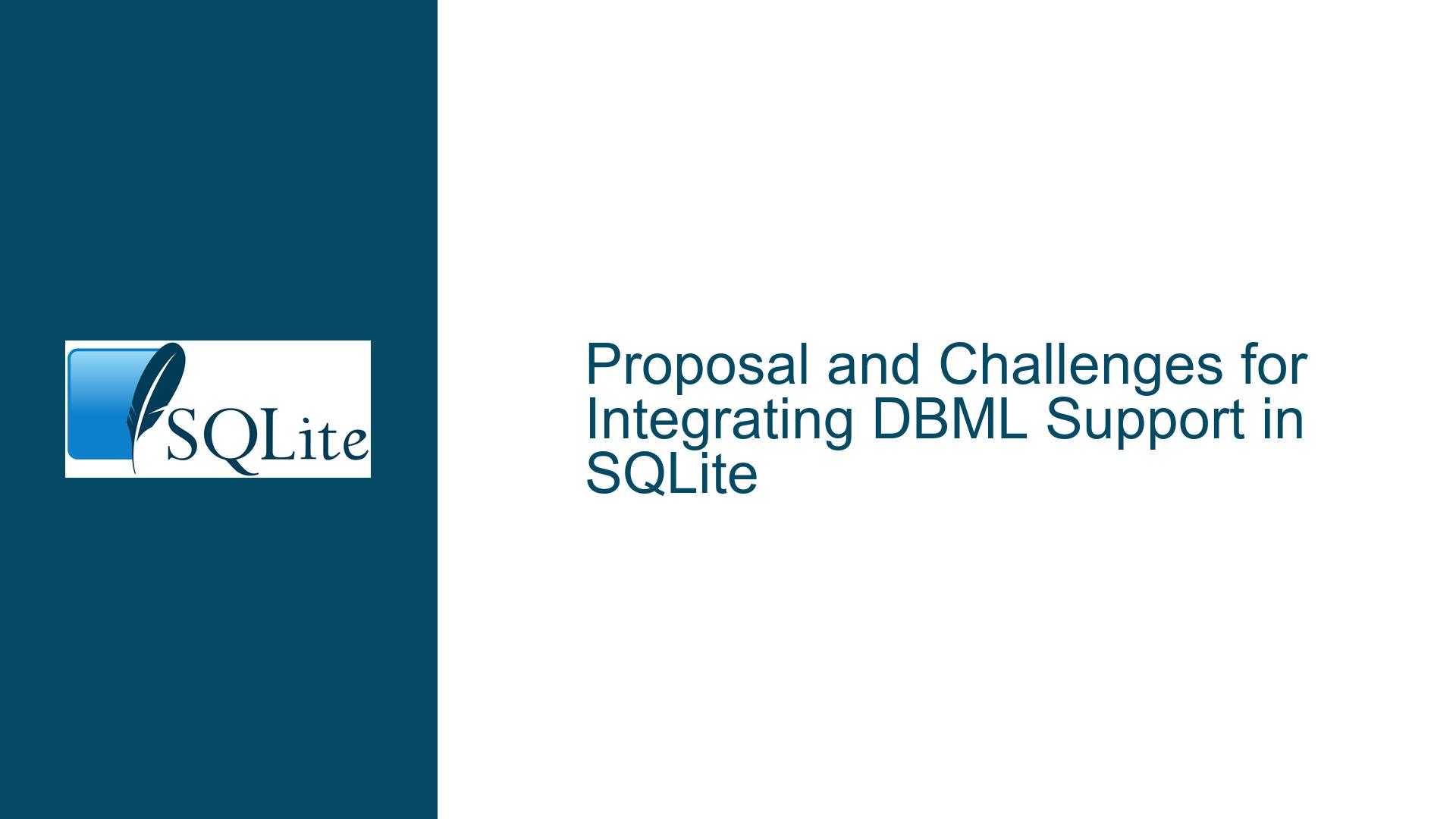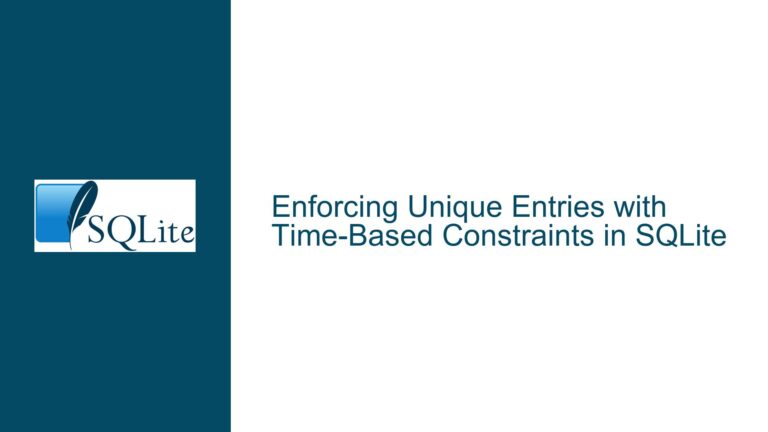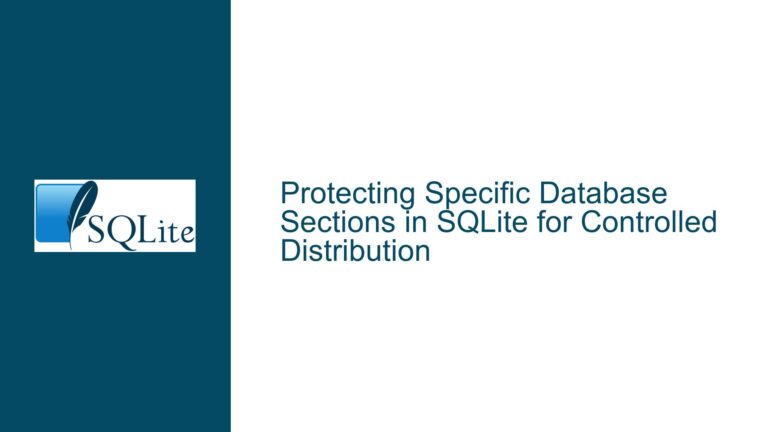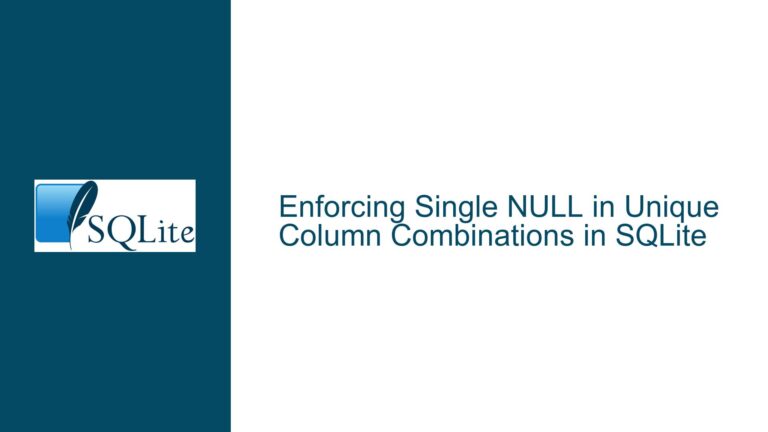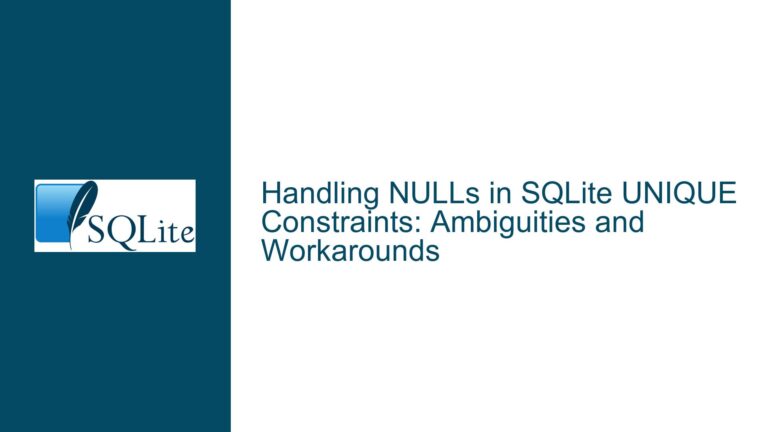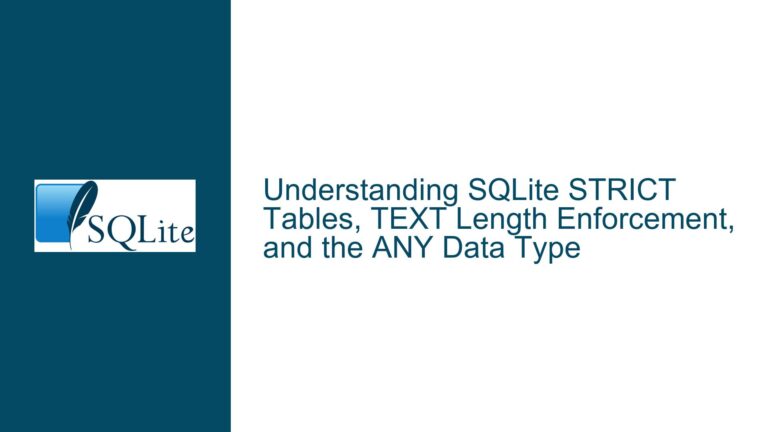Proposal and Challenges for Integrating DBML Support in SQLite
DBML Integration Proposal and SQLite Compatibility Concerns
The concept of integrating DBML (Database Markup Language) as a native schema definition language within SQLite raises questions about compatibility, design philosophy, and technical feasibility. DBML is a domain-specific language (DSL) designed to simplify database schema authoring through a human-readable, database-agnostic syntax. Proponents argue that DBML’s simplicity and tooling ecosystem (e.g., visualizers at dbdiagram.io) could enhance SQLite’s accessibility. However, SQLite’s minimalist architecture and adherence to SQL standards present inherent challenges.
A core issue is the mismatch between DBML’s abstractions and SQLite’s type system. For example, DBML defines timestamp and enum types, which SQLite does not natively support. SQLite uses dynamic typing (manifest typing), where any column can store any data type, and type affinity is merely a hint. DBML’s timestamp type assumes a specific storage format, but SQLite supports multiple timestamp representations (e.g., ISO-8601 strings, Julian day numbers, Unix epochs). Similarly, DBML’s enum type implies a restricted set of values, which SQLite enforces through CHECK constraints or auxiliary tables, not native enumeration support.
Another concern is the philosophical divergence between DBML’s goal of abstracting database-specific syntax and SQLite’s commitment to direct SQL execution. SQLite’s parser and execution engine are tightly coupled to SQL syntax, making it difficult to introduce a secondary schema language without significant architectural changes. Additionally, DBML’s "database-agnostic" approach may inadvertently obscure SQLite’s unique features, such as its file-based storage, lack of a separate server process, and support for in-memory databases.
The proposal also faces practical hurdles. SQLite’s parser is generated using the Lemon parser generator, which is not designed for runtime extensibility. Integrating DBML would require either embedding a secondary parser within SQLite (increasing binary size) or relying on external tooling to convert DBML to SQL. The latter approach already exists (e.g., dbml2sql), but proponents of native integration argue that tighter coupling would improve usability and foster community collaboration.
Technical and Philosophical Barriers to Native DBML Support
1. Type System Incompatibilities
- Timestamp Handling: DBML assumes a
timestamptype, but SQLite lacks a built-in timestamp data type. Developers must choose between storing timestamps as ISO-8601 strings, integers (Unix epochs), or real numbers (Julian days). This ambiguity complicates automatic translation from DBML to SQLite DDL (Data Definition Language). - Enum Limitations: DBML’s
enumrequires a closed set of values, which SQLite enforces viaCHECKconstraints or reference tables. For example, apost_statusenum with valuesdraft,published, andprivatewould need apost_statustable with foreign key constraints. DBML’s enum syntax does not map directly to SQLite’s relational model, requiring additional boilerplate SQL code.
2. Parser and Architecture Constraints
- SQLite’s parser is statically generated at compile time using Lemon. Adding support for a new language like DBML would necessitate either:
- Modifying the Lemon Grammar: This could introduce instability and increase maintenance overhead.
- Runtime Parsing Hooks: SQLite does not currently support dynamic parser extensions, and such a feature would conflict with its design goals of simplicity and small footprint.
- The SQLite team prioritizes backward compatibility and reliability. Introducing a secondary schema language risks fragmenting the ecosystem and complicating long-term support.
3. Philosophical Objections
- Presentation vs. Storage Layer: Critics argue that enums and other DBML features belong to the presentation layer, not the storage layer. SQLite’s focus is on efficient data storage, not rendering data for human consumption. For example, enforcing enum values via a reference table ensures data integrity without baking presentation logic into the schema.
- Tooling Overhead: SQLite’s success stems from its simplicity and portability. Adding DBML support would require maintaining converters, documentation, and compatibility shims, which could divert resources from core improvements.
Alternative Approaches and Workarounds for DBML-to-SQLite Translation
1. External Conversion Tools
- Use existing tools like
dbml2sqlto generate SQLite-compatible DDL. For example:dbml2sql --dialect sqlite schema.dbml > schema.sql sqlite3 mydb.db < schema.sql - Enhance converters to handle SQLite-specific quirks:
- Replace DBML
timestampwithTEXTorINTEGERcolumns, annotated via comments. - Convert enums to reference tables with foreign keys. For example:
CREATE TABLE post_status ( id INTEGER PRIMARY KEY, name TEXT NOT NULL UNIQUE, note TEXT ); INSERT INTO post_status (id, name, note) VALUES (0, 'draft', NULL), (1, 'published', NULL), (2, 'private', 'visible via URL only'); CREATE TABLE posts ( id INTEGER PRIMARY KEY, title TEXT, body TEXT, user_id INTEGER REFERENCES users(id), status INTEGER NOT NULL REFERENCES post_status(id), created_at TEXT );
- Replace DBML
2. Emulating Enums with Check Constraints
- For small enum sets, use
CHECKconstraints to restrict column values:CREATE TABLE posts ( ... status TEXT CHECK(status IN ('draft', 'published', 'private')) ); - For integer-based enums, combine
CHECKconstraints with a lookup table:CREATE TABLE posts ( ... status INTEGER CHECK(status BETWEEN 0 AND 2) );
3. Views for Presentation Layer Abstraction
- Create views to present enum values as human-readable strings:
CREATE VIEW v_posts AS SELECT p.id, p.title, s.name AS status FROM posts p JOIN post_status s ON p.status = s.id; - Use triggers to enforce read-only enum tables:
CREATE TRIGGER prevent_post_status_changes BEFORE DELETE OR UPDATE ON post_status BEGIN SELECT RAISE(ABORT, 'post_status is read-only'); END;
4. Community-Driven Solutions
- Contribute SQLite-specific translations to DBML tooling repositories.
- Develop lightweight middleware that converts DBML to SQLite DDL at design time, avoiding runtime dependencies.
5. Leveraging SQLite’s Flexibility
- Use SQLite’s comment syntax to annotate columns with DBML metadata:
CREATE TABLE posts ( body TEXT /* note: 'Content of the post' */ ); - Exploit SQLite’s extension mechanism (e.g., loadable extensions) to validate schemas against DBML definitions.
By addressing SQLite’s technical constraints through external tooling and schema design patterns, developers can achieve many of DBML’s benefits without requiring changes to SQLite itself. This approach aligns with SQLite’s philosophy of simplicity while leveraging its extensibility to bridge gaps between abstraction layers.
